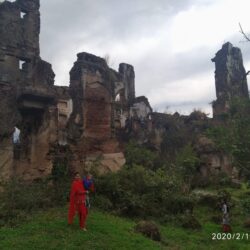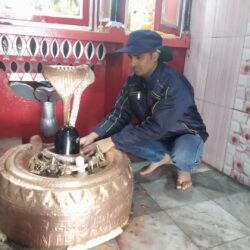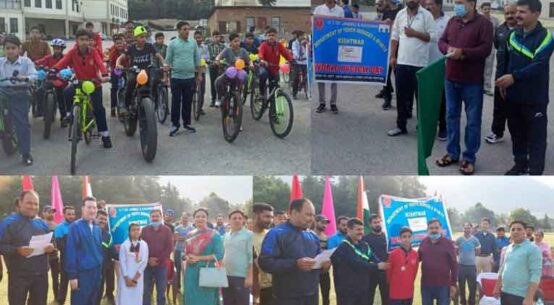
The Quest for the Ancient Shivalinga: Uncovering the History of Shri Neelkanth Mandir, Kishtwar
The history of Kishtwar is a tapestry woven with age-old traditions, yet many threads remain undocumented. For generations, oral accounts of Rajas, saints, and significant events have shaped our understanding. It wasn’t until the 20th century that historians and travelers began to record the narratives of Kishtwar. While deeply grateful for their pioneering efforts, the advancements in modern technology and research now offer an opportunity to re-examine and enrich our historical knowledge.
This endeavor is a humble contribution to the ongoing exploration of Kishtwar’s heritage. I present these findings with the hope of illuminating new facets of our shared past.
Raja Jagat Singh and the Conflict that Led to the Loss of the Shivalinga
In 1626 A.D., Jagat Singh ascended the throne of Kishtwar following the death of his father, Raja Gaur Singh. His brother, Bhagwan Singh, was then held hostage in Emperor Shah Jahan’s court in Delhi. Shortly after becoming Raja, Jagat Singh expanded his kingdom by invading and annexing Bhaderwah.
However, his absence proved costly. In 1627 A.D., Bhupat Pal, the Raja of Basohli, appointed Fateh Singh as his wazir and seized the opportunity to attack Kishtwar. With Raja Jagat Singh away, Basohli forces, led by the fierce warrior Kantak Balauria, faced minimal resistance and plundered the town.
Upon receiving this dire news, Raja Jagat Singh swiftly retreated from Bhaderwah and engaged the Raja of Basohli in battle to reclaim Kishtwar. Despite his valiant efforts, Raja Jagat Singh was martyred on the battlefield along with many of his soldiers. Following this victory, Bhupat Pal installed Kantak Balauria as his governor in Kishtwar and returned to Basohli, taking with him the revered Shiva Linga of Neelkanth Mandir, which was originally located near the Raja’s residence in the old bazaar.
The Enigmatic Story of the Neelkanth Mandir Shiva Linga
The Shiva Linga now enshrined in a temple near the old fort in Basohli is approximately one foot in height and half a foot in diameter, crafted from a fine, marble-like stone. This sacred Linga is associated with a remarkable tale.
Legend recounts that Raja Jagat Singh, while strolling in the Chougan (parade ground), was intrigued by a girl’s loud laughter. Upon inquiring, she narrated her past life as an eagle during the Mahabharata war in Kurukshetra. She recalled carrying the severed arm of a warrior, which bore an armlet containing a precious gem-studded Shiva Linga. This Linga, she revealed, was eventually dropped into a well in Kurukshetra.
To ascertain the truth of this extraordinary account, the Raja of Kishtwar journeyed to Kurukshetra, recovered the Shiva Linga from the well, and brought it back to Kishtwar. He installed it in the Neelkanth Mandir near his fort, where it was worshipped for a considerable time. It is believed that the presence of the Shiva Linga once again brought prosperity and peace to Kishtwar.
Another intriguing belief from that era suggests that individuals with pure hearts could see their past lives reflected in the highly transparent Shiva Linga. However, this changed when the Maharani, upon seeing the reflection of a she-monkey, cast the Linga into a fire, causing its color to turn black. This act of desecration is said to have angered the divine, resulting in famine and drought throughout Kishtwar.
The Aftermath: Basohli’s Rule and the Return of Bhagwan Singh
Following the conquest and plunder of Kishtwar, the Raja of Basohli, Bhupat Pal, married a princess of Kishtwar. Their son, Sangram Pal, who would later succeed to the throne of Basohli, was born in 1628 A.D. Sangram Pal became Raja in 1635 A.D. at the young age of seven. Known for his handsome appearance, he was summoned to Delhi in 1640 A.D. by Emperor Shah Jahan, where he was admired by the royal ladies. A brave and skilled commander, Sangram Pal is credited with winning twenty-two battles without a single defeat. He married twenty-two times but died without a male heir in 1673 A.D., after which his half-brother, Hindal Pal, succeeded him.
Upon learning of his elder brother Raja Jagat Singh’s defeat and assassination, Bhagwan Singh, who was still a hostage at the Mughal Court, secured an army of a thousand men from Shah Jahan and marched towards Kishtwar in 1642 A.D. Ghias-ud-din replaced Bhagwan Singh as a hostage in Delhi. Bhagwan Singh and the Mughal army advanced through the Marbal Pass and engaged the Basohli forces at Chougan. The battle resulted in a decisive victory for Bhagwan Singh’s forces, and Kantak Balauria is said to have been killed, his head used as a football by the jubilant locals on the Chougan ground. To commemorate this victory, a mela called Kantak Yatra was instituted, celebrated in Kishtwar until the 1950s A.D.
After reclaiming Kishtwar, the Mughal army returned to Kashmir with gifts. Bhagwan Singh is credited with extending his territory up to Ramban. Two Khatri brothers from Delhi, Kahn Pal and Jewan Pal, accompanied Bhagwan Singh from the Mughal court to assist in administration. Frederic Drew, in his book “The Jammoo and Kashmir Territories,” noted that the descendants of these brothers still resided in Kishtwar and served as advisors to the Raja, a hereditary occupation.
The Rediscovery of the Ancient Shivalinga in Basohli
My deep dive into historical accounts of the Neelkanth Mandir and its Shivalinga revealed a surprising omission: none of the authors or historians documented the initial discovery or recovery of this sacred artifact. There were no details or photographs to be found. This very Shiva Linga, I discovered, still resides in a temple in Basohli, near the old fort situated in the old bazaar, close to Ramleela Maidan. It is black in color, approximately twelve inches tall with a diameter of six to seven inches, and crafted from a fine, marble-like stone. The local community has diligently maintained this temple, and behind it lies a large pond reminiscent of the Sarkoot pond in Kishtwar. The ruins of the old Basohli fort nearby stand as silent witnesses to its past grandeur.
Driven by a desire to reconnect with this lost relic of Neelkanth Mandir, I embarked on a journey to Basohli. Upon arrival, I was astonished by the sheer number of Shiva temples, seemingly one every hundred meters. This abundance left me uncertain about how to pinpoint the specific Shivalinga I sought. Inquiries with numerous locals yielded no definitive information.
Seeking more knowledgeable insights, I visited the local government degree college, hoping that history professors might possess information about the temple. The professors welcomed me warmly, but even they could not provide a specific answer, explaining that with so many Shiva temples, detailed knowledge of each was limited.
During our conversation, a thought struck me: if the Raja of Basohli had indeed invaded Kishtwar, slain its ruler, and taken such a precious relic, wouldn’t he have kept it near his palace? I posed this question to the professors, asking if a palace with a Mahadev temple existed nearby. They confirmed the existence of such a site, though the palace was now in ruins. This, I exclaimed, must be the temple I was searching for – a valuable relic would naturally be kept close to the seat of power. The professors were intrigued by this reasoning.
Following their directions, I made my way towards the location. I soon found a Shiva temple being meticulously prepared for the upcoming Mahashivratri festival. Inquiring with the locals if this was the temple housing the Shivalinga brought from Kishtwar, I was met with surprise. They were curious as to why someone from Kishtwar would be searching for this particular temple. Upon explaining my origins and quest, the locals exchanged astonished glances, remarking that in all their years, they had never encountered anyone from Kishtwar visiting this temple in search of the Shivalinga. My search had clearly sparked a sense of wonder in the community.
A Moment of Connection and a Plea for the Shivalinga’s Return
Stepping into the temple, the sight of the Shivalinga deeply moved me. It felt as though it held a silent resonance, a sense of having waited for centuries to be reunited with its original home. Any devout Sanatani aware of this ancient Shivalinga and holding faith in its significance would undoubtedly yearn to behold it and should consider visiting Basohli at least once to experience its majestic presence.
Despite the local residents’ commendable efforts in maintaining the temple, the Shivalinga’s inherent connection to its place of origin echoes the universal human longing for homeland. Behind the temple lies a large pond, and to the east stand the ruins of what must have been a grand palace, evident from its remaining architecture and construction.
We undertake pilgrimages to numerous sacred sites. Should we not also embark on a journey to Basohli to pay homage to this ancient Shivalinga, forcibly taken from Kishtwar and established there? Can we remain unaware of its true origins?
Is it conceivable that the people of Kishtwar will one day strive to bring this Shivalinga back to its original location? I sincerely hope that the Sanatan Dharm Sabha and other organizations in Kishtwar will take concrete steps to facilitate its return. While we often speak of our cultural heritage, tangible actions are rare. I earnestly appeal to these organizations to collaborate with the local administration and make a concerted effort to ensure the Shivalinga is reinstated in its rightful place.
Authored by: ANIL KUMAR BHAGAT
Mobile: 7051350159
Email: anilk11111982@gmail.com
Disclaimer:This article presents the author’s personal research and interpretation of historical events. www.mykishtwar.com provides this platform for the dissemination of information and diverse perspectives. The accuracy, completeness, and validity of any statements made within this article are solely the responsibility of the author. The content of this article is the sole responsibility of the author. www.mykishtwar.com does not assume any liability for the information presented. The author’s views and opinions do not necessarily represent those of www.mykishtwar.com. Readers are encouraged to conduct their own research and verify the information presented.




